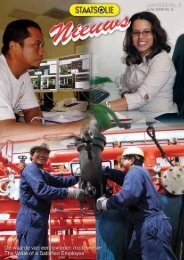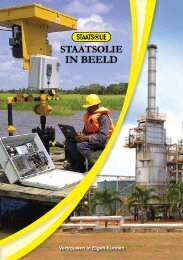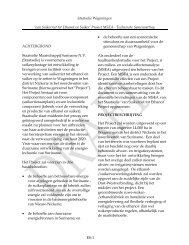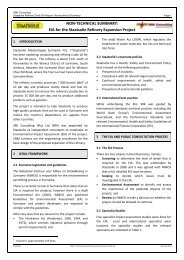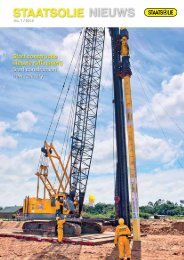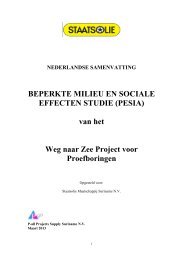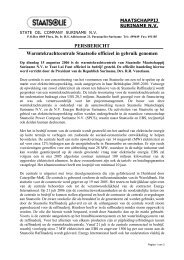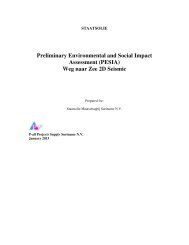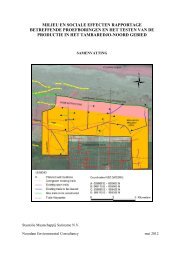concept EIA-rapport - Staatsolie
concept EIA-rapport - Staatsolie
concept EIA-rapport - Staatsolie
You also want an ePaper? Increase the reach of your titles
YUMPU automatically turns print PDFs into web optimized ePapers that Google loves.
SRK Consulting: Project No: 439414 <strong>Staatsolie</strong> Pipeline <strong>EIA</strong> – Draft <strong>EIA</strong> Report Page 68<br />
It is not expected that new employment will be created during the operations phase. Rather, existing<br />
<strong>Staatsolie</strong> employees or contractors will assume the tasks of operating, monitoring and maintaining<br />
the pipelines.<br />
6.6 Potential impact: Disruptions to road and river traffic<br />
Potential impacts of the pipeline project on transportation may result from the:<br />
• Movement of construction vehicles;<br />
• Limited restrictions imposed on river traffic during pipeline stringing; and<br />
• Transport of construction materials, equipment and workers to and from the work sites.<br />
Road traffic<br />
Transportation infrastructure in Suriname and in the greater Paramaribo area is experiencing<br />
increased demand and is characterised by a gradually deteriorating road network, although<br />
initiatives to upgrade certain roads are being implemented. Walking and cycling are important modes<br />
of transport in rural and urban areas, although few formalised facilities are provided for these. Given<br />
the generally poor state of the transportation network combined with the high number of pedestrians,<br />
mopeds and cyclists, road safety is a concern in the country and in comparison to other countries<br />
there is a fairly high fatality rate.<br />
The drill pads and other work areas will be accessed mainly via Sir Winston Churchill Road and the<br />
local, unsurfaced road network. During the construction phase, some heavy vehicles will utilise the<br />
local road network to access the site to deliver materials and equipment. No information is available<br />
on the expected numbers of heavy construction vehicles that will service the sites, but traffic is<br />
expected to be limited. Similarly the number of vehicles transporting the workforce will also be<br />
limited.<br />
As a result, the additional (local) traffic due to the pipeline construction is expected to be relatively<br />
minimal, with low intensity impact on the local road network (congestion, community safety and road<br />
deterioration). The impact would be localised and of short-term duration, as the level of construction<br />
phase traffic would not be constant for the entire duration of the construction phase.<br />
River traffic<br />
The lower Suriname River is a major transportation route and provides shipping access to a number<br />
of businesses located along the pipeline route. Other users of the river include commercial,<br />
subsistence fishermen, cargo vessels, sand barges, tourism operators and passenger transport<br />
providers. As such, a high number and variety of vessels utilise the Suriname River.<br />
During the construction phase of the pipeline project, some material (e.g. sand) will be delivered by<br />
barge to the drill pads. However, this is not expected to result in a noticeable increase in river traffic.<br />
The drill rigs will be land-based. The pipeline strings will be laid out on the river before insertion into<br />
the drill hole. This is likely to necessitate restrictions to river traffic along the section where the string<br />
is laid out for approximately 3 to 4 days per HDD section. Jetties in the vicinity and small boat<br />
operations may be impacted. Drilling activities will not impose other restrictions or have other<br />
impacts on river traffic in the study area.<br />
The potential impact of road and river traffic related to the construction phase of the project would<br />
therefore be of medium intensity and of local extent and of short-term duration. It is therefore<br />
assessed to be of very low (negative) significance. The implementation of the recommended<br />
mitigation measures would reduce the intensity of the interference with and increased safety risks to<br />
other road and river users, although the residual impact remains very low (negative) (see Table<br />
6-10).<br />
REUT/DALC 439414_<strong>Staatsolie</strong>Pipeline<strong>EIA</strong>_Draft <strong>EIA</strong> Report_Final June 2012




